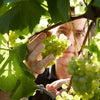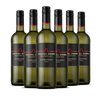As spring unfolds across the Kent countryside, there’s a subtle but important transformation taking place in the vineyard. Among the rows of dormant vines, the first signs of life are beginning to show—soft, silvery buds emerging from the canes in what’s known as the woolly bud stage.
It’s a moment of quiet anticipation. While it may look like a gentle awakening to the untrained eye, this stage marks the very beginning of the new growing season and is a critical phase in the cycle that leads to harvest, and ultimately a new vintage in the glass.
What Are Woolly Buds?
After lying dormant through the winter, grapevines slowly begin to stir as temperatures rise. The first visible sign of this awakening is budburst—when tiny buds begin to swell on the vine. These buds are covered in fine, downy hairs, giving them a soft, wool-like appearance. This is what gives the “woolly bud” stage its name.
At this point, the buds are still tightly closed, but inside, the vine is hard at work. Energy stored over winter is being used to fuel new growth, preparing the vine for the season ahead. What follows in the coming weeks is a transformation—woolly buds give way to visible leaves and shoots, and before long, flower clusters begin to form.
Why This Stage Matters
The woolly bud stage is a sign that the vineyard is beginning its new cycle. Timing is crucial. Early warmth might encourage a quicker budburst, but this also increases the risk of damage from frosts. Conversely, a colder spring can delay development, pushing harvest dates further into the year.
At Chapel Down, our vineyard team keeps a close watch on the weather and the progress of the vines during this period. Decisions made now—from pruning techniques to frost protection—can have a lasting impact on the health of the vine and the quality of the fruit it will eventually bear.
A Delicate Balance
The arrival of woolly buds is also a reminder of the balance between natural forces and the skill of the vineyard team. While the soil, climate, and landscape shape much of the vine’s development, careful human intervention is key.
Sustainable vineyard practices help ensure that the vines begin their season strong and healthy. Encouraging biodiversity, protecting soil structure, and managing canopy growth all start to come into focus as the vines move from dormancy into active growth.
From Bud to Bottle
It’s remarkable to think that the small, velvety buds seen on the vine in early spring will eventually become the grapes harvested for our sparkling and still wines. Each stage of growth builds upon the one before, and it all begins here—with the humble woolly bud.
For visitors to the vineyard at this time of year, it’s a beautiful and fascinating sight. A quiet signal that something is beginning. A new chapter, and a new vintage, waiting to unfold.
The Start of Something Special
As the growing season gets underway, the arrival of woolly buds represents a moment of promise and potential. It’s a subtle but essential step in the journey from vine to glass—and a reminder that great wines always begin in the vineyard.
To learn more about our seasonal vineyard practices or to plan your visit to see the vines in action, head to chapeldown.com.

















